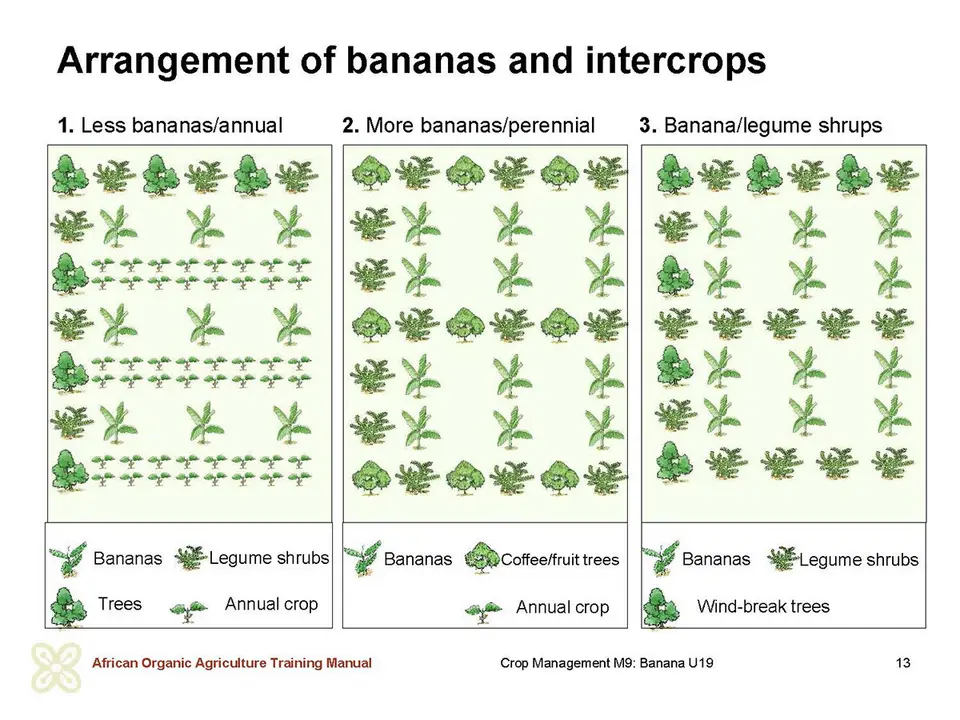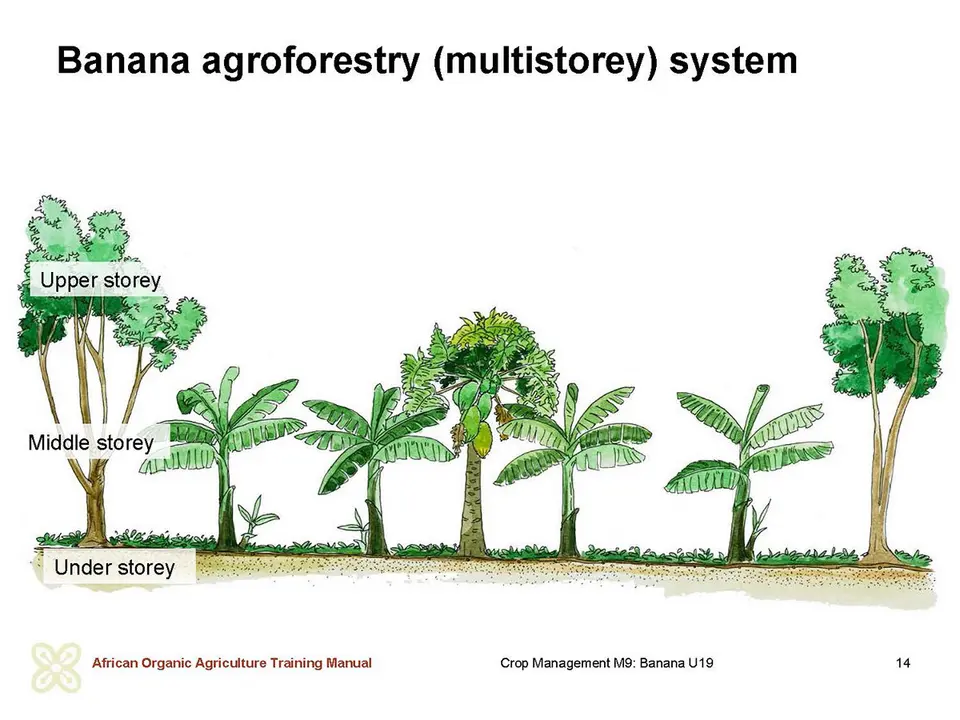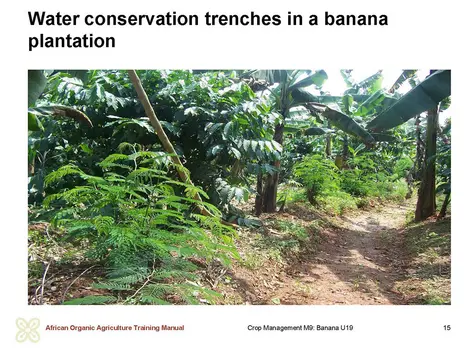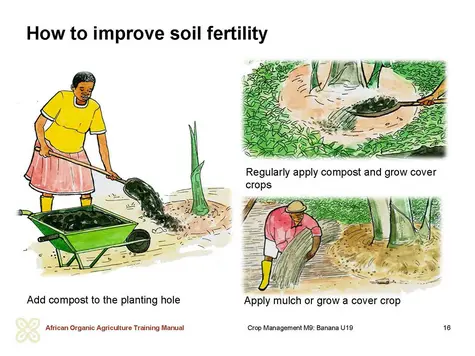Improving the productivity of the banana plantation
Discussion: Improving productivity of banana plantations
Ask the farmers to give examples of local species of trees that can be grown with bananas. What other benefits do these trees provide and how should these trees be managed within a banana plantation?
Intercropping
During the first two years of banana establishment, a good amount of space exists between the rows of bananas. This space should be planted with seasonal crops that do not compete with bananas in order to protect the soil from erosion, but also to provide extra harvest for the farmer. Using leguminous intercrops also contributes to soil fertility improvement directly by fixing nitrogen or indirectly by providing mulching material. Common intercrops include legumes like beans, groundnuts and soybean or vegetables like cabbage and tomatoes. Bananas can also be intercropped with coffee, vanilla, cocoa, avocado, passion fruits, pineapples, or pawpaws. A minimum distance of 60 cm should be maintained between the banana plants and the intercrops.
Trees are also needed in a banana plantation for providing shade and for protection from strong winds. Strong winds shred banana leaves and can lead to serious toppling, especially in tall cultivars. In areas with strong winds, it is important to establish windbreaks long before planting bananas. Such trees will need regular pruning to avoid too much shading during early growth. New planting of shade trees can also be done at the same time as planting of bananas. In either case, trees should combine well with other crops to form a banana agroforestry (multistorey) system.
However, shade in the banana plantation needs to be regulated; too much shade causes elongation of the plants and results in small bunches. Shade trees should be pruned regularly, especially at the beginning of the rainy season to reduce overhead shading.
Banana agroforestry (multistorey) system
The banana garden should be established in a mixture of tall and short crops to form a multistorey system. Multistorey means that there are different layers of plants growing to different heights in the system. Three levels (storeys) are important in a banana agroforestry plantation:
a. Crops of the upper storey (shade)
Shade trees protect the plants against strong winds and hailstorms. Common tree species that can be used as shade trees include Grevelia robusta, Ficus natalensis, Albizia coriaria, Mesiopsis eminii, Cordial africana, Acacia or Erythrina spp. Fruit trees such as mango, avocado or jackfruit can also be included at intervals.
b. Crops of the middle storey
Depending on the needs of the farmer, fruit trees (e.g. citrus, paw paws), coffee, cocoa or vanilla can be integrated as middle storey crops. However, these should be included at a much wider spacing since bananas themselves feed at this level. Multipurpose leguminous trees can also be planted within the garden or along the boundaries (e.g. Leucaena diversifola, Calliandra calothyrsus, Sesbania sesban, Gliricidia sepium). They fix nitrogen into the soil and also provide mulch for the field when pruned. Trees like (e.g. Glyricidia sepium and Leucaena leucocephala), should always be cut back at the banana plant’s height once a year, so that around 15 % of their leaves remain.
c. Crops of the understorey
The understorey will comprise the annual crops that will be intercropped with bananas during early growth. As the plants grow bigger, the ground cover will then be replaced with green manure legumes. Legume ground covers are preferred as understorey crops, for example, jack bean (Canavalia ensiformis), or Lablab (Lablab purpureus). Any other perennial non-climbing species can also be used but they should be regularly pruned.
Improving soil fertility
A healthy soil provides the foundation for a healthy banana crop and sustainable production. There are two approaches to building a fertile soil in a banana garden. First is to prevent soil, organic matter and water loss. Second is to grow crops that feed the soil or directly add organic manures, compost and other organic amendments to improve the soil organic matter content and nutrients.
Soil and water conservation measures
Water stress affects banana yields by influencing the size of the bunch and the fingers. It is, therefore, important that banana farmers make all possible efforts to conserve as much water as possible in the banana fields. Making soil bunds or terraces depending on sloping terrain is needed in order to trap runoff water. The terraces should further be stabilized with grass and legume shrubs. Shade trees also assist in conserving moisture within the plantation.
Mulching is very important in a banana plantation. It conserves soil moisture, improves soil structure, limits weed growth and controls soil erosion. When mulching, lay mulch across the slope and place it about 2 feet away from the banana stool. Mulching too close to the stool provides hiding places for weevils and encourages bananas to produce suckers too close to the mother plant. The mulch should be maintained because banana roots develop just below the mulch where there is good moisture. Such roots will dry off under strong sunshine when there is less mulch. It is highly recommended for banana farmers to grow their own mulch close to the banana plantation or along soil bunds and partitions within the banana plantation. This is the best way to ensure a constant cheap supply of mulching materials. Common sources of mulch used in bananas include Elephant grass (Pennisetum purpureum), Guatemala grass (Tripsacum laxurn) and wild sunflower (Tithonia spp). Crop residues such as coffee husks, bean husks, maize stover and sorghum stover can also be used for mulching bananas.
As already mentioned, leguminous cover crops such as jack beans (Canavalia ensiformis), velvet beans (Mucuna pruriens) or Lablab (Lablab purpureus) also provide a source of mulching in the understorey. They suppress weeds, fix nitrogen and control soil erosion. However, cover crops should be pruned regularly so that they do not compete with the banana plants.
Organic manures and compost
In addition to the above organic materials, compost and animal manures should also be applied. Compost is best applied in the planting holes of young banana seedlings while animal manures should be added, whenever available, as a top-dressing but most importantly close to the flowering stage to improve growth and productivity. Poultry manure is preferred because it is particularly rich in nitrogen (N).
There are also a variety of other local amendments that have been used to improve banana yields:
- Wood ash from the kitchen is also a good source of potassium (K).
- Animal urine (including human urine), is a good nitrogen source and if mixed with hot chilli, has also proved effective in weevil control.
Group work on soil fertility management in banana plantations
Organise a field visit to selected banana plantations. Let the farmers examine the soil and make recommendations on how soil fertility can be improved in the different plantations.
Proper weed management
Banana trees are highly susceptible to weed competition especially during the first year of establishment. Therefore, timely weeding is necessary in order to achieve good yields. Weed management can be achieved by mulching, cover cropping or mechanical means.
During early growth (up to one year), when annual crops are still intercropped within the young banana plants, mechanical weeding is feasible. After 1 to 2 years, usually no weeding activities are necessary. At this stage, digging/tillage in the banana plantation is not recommended to avoid damaging banana roots. Usually, most banana roots do not go deep (less than 30 cm depth), but they spread out widely forming a mat of up to 1.5 m in width. Damaging the roots through tillage reduces their capacity to take up nutrients and water. Mulching and zero tillage are highly recommended practices in a banana plantation. Mulching limits weed growth while zero tillage improves soil structure and minimizes damage to banana roots.




 tap and then scroll down to the Add to Home Screen command.
tap and then scroll down to the Add to Home Screen command.